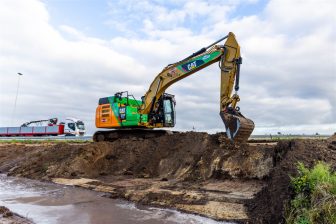Eurotunnel Traffic and Revenue in 2006
- Revenue increased by 5% to £568 million
- Shuttle services revenue, Eurotunnel’s core business, increased by 7%
- Almost 1.3 million trucks and more than 2 million passenger vehicles transported on Eurotunnel Shuttles
Folkestone, Kent, United Kingdom – In 2006 Eurotunnel has had an excellent year, recording revenues of £568 million, an increase of 5%, compared to the previous year at constant exchange rates. This growth is principally due to the results from Eurotunnel’s Passenger and Truck Shuttle activities, the core business, which, for the second year in a row, has increased significantly: +7%, to £318 million.
The increase in Eurotunnel revenues comes at a time when the company no longer seeks to increase its volumes as a priority: the number of cars and trucks transported is now stable (-1%), by comparison to the preceding year.
Jacques Gounon, Eurotunnel Chairman and Chief Executive said:
“Eurotunnel has seen a significant growth in revenue from the now mature cross-Channel market, for the second year in a row. These excellent results are ahead of the business plan which has served as the foundation for the company’s financial restructuring and are an encouraging indicator for the success of the safeguard plan”.
Eurotunnel revenue
Total revenue for Eurotunnel, which includes both transport and non-transport activities, has reached £568 million in 2006. At constant exchange rates, this equates to an increase of 5% when compared to the previous year. (Eurotunnel revenue was in decline between 2002 and 2004). It rose by 1% between 2004 and 2005.
The Shuttle services which link Folkestone (UK) to Coquelles (France), carrying trucks or passenger vehicles are the main driver for this growth: their revenues have grown by 7% (to £318 million).
- The Passenger Shuttle service has played a substantial role in this performance in 2006: the company’s new pricing approach has shown itself to be perfectly adapted to the market. It allows us to attract and develop customer loyalty in the most profitable segments.
- The transport of trucks remains Eurotunnel’s spearhead and continues to generate the majority of Shuttle services revenue. Revenues are growing in phase with activities and have benefited appreciably from the end of the use of intermediaries in the sale of this service.
Revenues from the Railways are slightly higher (+2%) at £240 million. They include payments due under the Minimum Usage Charge (MUC), £65 million for 11 months of 2006. The ending of this arrangement on 30 November 2006, has deprived Eurotunnel £6 million of revenue compared with 2005. Pro forma, over 12 months, Eurotunnel’s total revenue would have increased by 6%.
Non-transport revenue remains marginal.
Channel Tunnel Traffic
The quality of services offered by Eurotunnel, the speed, ease and reliability of its transport system, has led several million customers to choose Eurotunnel’s Shuttle Services to cross the Channel in 2006.
Eurotunnel Shuttles
1,296,269 trucks, representing more than 17 million tonnes of goods, were carried on Eurotunnel Truck Shuttles in 2006 – volumes less than 1% below those for 2005 which was Eurotunnel’s record year, largely due to the exceptional transfer of traffic from the port of Calais during the first half of 2005. Viewed against 2004, which offers a comparable reference point, truck traffic has increased by more than 15,000 units.
In a market which has been in long term decline, the Passenger Shuttle service attracted 2,021,543 cars (-1%) and 67,201 coaches (-13%) equal, to more than 7.5 million people.
Railway traffic
7,858,337 passengers travelled through the Channel Tunnel on Eurostar* in 2006, constituting an increase of 5% by comparison to 2005. The growth in traffic, slowed by the terrorist attacks in London in July 2005, has taken off again in 2006. Eurotunnel, due to the mode of calculation of tolls, does not benefit from this increase in traffic. However, as a result of its decision to grant Eurostar priority over its own Shuttles for passage through the Tunnel, Eurotunnel has contributed to the improvement in Eurostar punctuality, thus helping its principal customer to achieve its commercial strategy.
The railway companies’ freight trains carried 1,569,429 tonnes of goods in 2006, 1% less than in 2005. This traffic remains well below the original forecasts and the capacity of the Channel Tunnel. Eurotunnel is examining, with the railway freight operators SNCF and EWS, the conditions which would enable this continuing decline to be reversed.
Eurotunnel manages the infrastructure of the Channel Tunnel and operates accompanied truck shuttle and passenger shuttle (car and coach) services between Folkestone, UK and Calais, France. Eurotunnel also earns toll revenue from train operators (Eurostar for rail passengers, and EWS and SNCF for rail freight) which use the Tunnel. Eurotunnel is quoted in London, Paris and Brussels.
U las zojuist één van de gratis premium artikelen
Onbeperkt lezen? Profiteer nu van de introductieaanbieding voor € 10,- per maand.
Bent u al abonnee?



